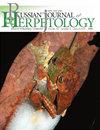南奥塞梯Darevskia Arribas属一新种,1999年(爬行纲:爬行纲:Lacertidae)
IF 0.9
4区 生物学
Q3 ZOOLOGY
引用次数: 0
摘要
Darevskia Arribas属的一种新的岩蜥蜴,1999年——Darevskiia arribasi sp.nov.在南奥塞梯的Ertso湖附近被描述。Darevskia arribasi sp.nov.与“saxicola brauneri”复合体的其他物种[D.lindholmi(Szczerbak,1962),D.saxicol(Eversmann,1834),D.brauneri(Mehely,1909)(包括D.b.brauneri,D.b.myusserica Doronin,2011,D.b.darevskyi(Szzerbak,1962年)和D.szczerbaki(Lukina,1963)]的比较,新物种的特征是在该复合体的所有代表中体型最小♂♂ — 55–62毫米;♀♀ — 58–63毫米。D.arribasi sp.nov.(52–58,更常见的是54–56)身体中部周围的鳞片数量(平方米)也明显少于D.saxicola sensu lato。沿着喉咙,从耳朵到耳朵的褶皱有36-42个鳞片,比沙氏锥虫的鳞片还少。在接受检查的一半个体中,肛门护罩前面有两个大的肛门前护罩;在四分之一的个体中,在小的中央额前两侧有一个扩大的侧额前护罩,在另四分之一中,所有额前护罩大小相同。中央颞叶(Massetericum)始终发育;总是六对下颌,三对接触;衣领直,极少数有轻微锯齿;尾鳞上的肋骨有一定程度的表达;通常用鼻罩将额鼻与额鼻分开。成年雄性的颜色是橄榄生菜,或者从上面看是橄榄棕色;成年雌性为灰褐色;幼鱼色咖啡褐色,具蓝色和黑色斑点,在树干中部的外侧腹侧盾的边缘。线粒体细胞色素b数据的分析结果很好地支持了新物种的分类状态。本文章由计算机程序翻译,如有差异,请以英文原文为准。
A New Species of the Genus Darevskia Arribas, 1999 from South Ossetia (Reptilia: Sauria: Lacertidae)
A new species of rock lizards of the genus Darevskia Arribas, 1999 — Darevskia arribasi sp. nov. is described from vicinity of Ertso Lake in South Ossetia. In comparison of Darevskia arribasi sp. nov. with other species of the «saxicola-brauneri» complex [D. lindholmi (Szczerbak, 1962), D. saxicola (Eversmann, 1834), D. brauneri (Mehely, 1909) (including D. b. brauneri, D. b. myusserica Doronin, 2011, D. b. darevskyi (Szczerbak, 1962), and D. szczerbaki (Lukina, 1963)], the new species is characterized by the smallest body size among all representatives of this complex L♂♂ — 55 – 62 mm; ♀♀ — 58 – 63 mm. The number of scales around the middle of the body (Sq.) in D. arribasi sp. nov. (52 – 58, more often 54 – 56) also significantly less than for D. saxicola sensu lato in generally. Along the throat from ear to ear fold there are 36 – 42 scales, less than in D. saxicola sensu lato. Two large preanal shields present in front of the anal shield in half of the individuals examined; in a quarter of individuals on both sides of the small central preanal there are by one enlarged lateral preanal shield, in another quarter all preanal shields are of the same size. Central temporal (Massetericum) always developed; always six pair of mandibulars, three in contact; collar straight, extremely rarely slightly serrated; ribs on the caudal scales are expressed to some extent; rostral usually separated from frontonasal by nasal shields. The coloration of adult males is olive-lettuce, or olive-brown from above; adult females are grey-brown; juvenile coloration coffee-brown with the blue and black spots on the edge of the outer ventral shields at the middle of trunk. Taxonomical status of new species is well supported with result of analysis of the mitochondrial cytochrome b data.
求助全文
通过发布文献求助,成功后即可免费获取论文全文。
去求助
来源期刊

Russian Journal of Herpetology
ZOOLOGY-
CiteScore
1.70
自引率
0.00%
发文量
29
期刊介绍:
Russian Journal of Herpetology is an international multi-disciplinary journal devoted to herpetology. Russian Journal of Herpetology accepts original papers on ecology, behavior, conservation, systematics, evolutionary morphology, paleontology, physiology, cytology and genetics of amphibians and reptiles.
Types of Contributions:
-original papers
-invited or contributed reviews on specific topics
-short communications on topics of immediate interest, new methods and ideas in progress
-notices of meetings, symposia, and short courses
-book reviews
 求助内容:
求助内容: 应助结果提醒方式:
应助结果提醒方式:


